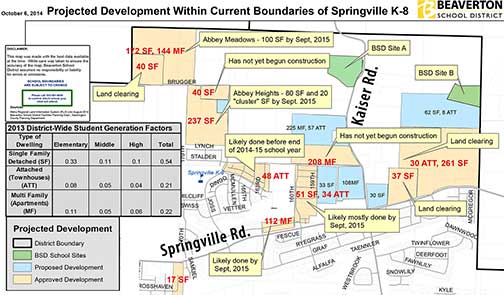 |
Previous Issues |
| Cedar Mill Community Website |
|
Search the Cedar Mill News: |
About The Cedar Mill News |
|
|||||||
| Volume 14, Issue 2 | February 2016 |
||||||
Is BSD planning adequately for growth in our area?
|
||||
 |
| Graphic adapted from “New Housing Developments” document, 9/23/2014, produced as part of the packet for the decision process for the Springville K-8 - Stoller Middle School Overcrowding Solutions. |
Until recently, BSD has been interpreting “capacity,” when submitting SPLs, as district-wide capacity, but the county is interested in local capacity. This reinterpretation is leading to questions.
Andrew Singelakis, Washington County Director of Land Use and Transportation, wrote to Ron Porterfield, BSD Deputy Superintendent, around the same time, that, “Without better guidance from the District, we believe these land use applications (Bethany Creek Park and Arbor Bonny Slope West) are likely to be appealed. The application could be appealed by residents if we approve in light of the SPLs. The application could be appealed by developers if we deny the applications based on school capacity.”
Singelakis now states, however, that, “BSD’s bond program to build and improve schools is a proactive way to address growth in the County, which will address system-wide capacity issues. Our Community Development Code and state law describes a series of tools that school districts can use to address over-crowding in individual schools, which the district employs.”
He continues, “Since these tools are employed, we feel that we have no basis to deny subdivision applications based on school capacity issues. To do so would invite developer appeals, which we believe we would lose if we did deny. BSD did have language in previous service provider letters that talked about these tools and how they can be used to mitigate shorter-term capacity issues in individual schools. LUT is concerned that taking this language out could invite appeals of subdivisions by neighbors. BSD has not asked the county to deny subdivision applications.”
Another issue that seems to be affecting the ability for BSD to accommodate growth is a potential lack of coordination among the various service districts that provide urban services to the unincorporated areas. For example, BSD acquired two parcels of land north of Springville, in an area that is filling quickly with houses. Plans to build a K-8 school at the site closer to homes currently under development had to be abandoned because Clean Water Services (CWS) doesn’t have sewer capacity to serve that parcel. A K-5 school will be built at another north Bethany site, currently isolated from new development. That site also poses problems in delivering utilities.
Singelakis says, “We have been meeting with CWS and BSD regularly, primarily about the elementary school in Bethany. However, other issues do come up in these meetings. LUT and the District have been discussing ways to expand upon this coordination.”
Voters passed a Bond Measure in 2014 that raised $680 million for capital projects, which included modernization and repair (55%), additional capacity (35%), and technology upgrades (10%). The total for additional capacity comes to around $238 million. The new middle school in Timberland will cost about $52 million, but won’t be available to increase capacity until 2020, when it finishes being a temporary location for other school populations while their schools are being rebuilt. The new high school at the southern border of the district will cost around $109 million. $3 million was allocated for land acquisition for a new elementary school. $25 million will be used to build the Kaiser Road K-5. The remaining money is earmarked for contingencies.
In addition, since 2007, schools in Oregon may collect a Construction Excise Tax (CET) on new building in the district. The current state maximum is $1.20 per square foot on residential structures, and $0.60 on non-residential uses. Beaverton collects the maximum for both types.
Many people who are concerned about school capacity in the northern part of the district find it troubling that the CET funds that result from new construction are not being used to buy land or build schools, but instead are being used to service *debt incurred for other projects in the district. Although it is apparently a legal use of the funds, they wonder if this is the best use of CET funds. Some would prefer to see some of that money set aside to deal with the school population growth that generates the funds.
Crowded classrooms, playing fields filled with portables, divided neighborhoods, students spending time on long bus rides that clog the roads and contribute to greenhouse gases—we can only hope that BSD is able to catch up to development before these troubles get worse.
*The Full Faith and Credit Obligation (FFCO) issued in 2009 paid for portions of the following: ACMA Auditorium, Health Sciences Option School remodel, Transportation Service Center, and bus particulate filters. The FFCO payments have been funded with a combination of General Fund and CET resources.
![]()
Like us on Facebook for timely updates
Published monthly by Pioneer Marketing & Design
Publisher/Editor:Virginia Bruce
info@cedarmillnews.com
PO Box 91061
Portland, Oregon 97291
© 2016